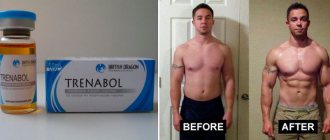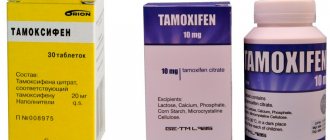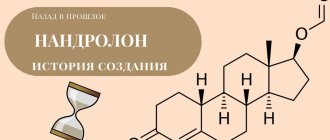One of the main issues regarding the use of anabolic steroids is the length of the cycle of taking these drugs. This duration lies within a very wide range - from two weeks to... several years. But year-round use of anabolic steroids is, as a rule, the lot of professional bodybuilders; we will consider the features and practice of using “long cycles” in our subsequent publications. Regular users are limited to a cycle length of 6-12 weeks. But “middle cycles” are not the topic of our conversation. Today we will talk about the so-called “short cycles”.
Short cycles came into fashion thanks to the light hand of the American “guru” of pharmacology Bill Roberts - it was he who introduced the “2+4” cycle into use. For the uninitiated, I’ll explain: 2 is the number of weeks allocated for “pharmacological loading”, 4 is the number of weeks required for recovery. In addition to Bill Roberts’ “2+4”, more complex cycles “3+1+2+3” and “3+1+4+2+5+3” are also in use. We will not complicate an already difficult topic and immerse you in the jungle of mathematical constructions. We simply offer for your consideration, dear readers, our own cycle, quite simple, built according to the “3+3” scheme. An interesting difference between this type of cycle is that similar schemes are used not by just anyone, but by the elite of professional bodybuilding.
Advantages and disadvantages of short cycles
The advantages of short cycles are obvious - suppression of the production of your own testosterone begins 15-21 days after the first injection (first dose of the oral drug). That is, by following short cycles, you will not suppress the production of endogenous testosterone, which means you will be able to endure a break from taking anabolic steroids quite painlessly, without compromising your gains. In addition, you will always only increase achievements, and not follow a slightly modified Leninist formula of “two steps forward - one step back - two steps forward” or the cycle dubbed by my colleague Dmitry Kononov the “inflated - deflated” cycle. And it’s easier to adjust your training program to short cycles - it naturally fits into such periodization.
There are also many disadvantages. Firstly, the choice of drugs is sharply narrowed, we will talk about this in the corresponding chapter. Secondly, the cost of such a cycle will still be slightly higher than the cost of a “direct cycle” lasting 10-12 weeks due to the use of more expensive drugs. Thirdly, it is impossible to achieve impressive progress in gaining muscle mass in a few weeks. Although... here you can doubt it very much. But let's not run ahead of the locomotive - practice will show everything.
A course of steroids for mass is not for beginners
First course of steroids for a beginner | best courses to start with
Course 12 weeks
Take from 1 to 6 weeks. Then we take a break for 2-3 weeks and take it again until the end of the course.
- Dianabol – 40 mg per day
- Anadrol - 50 mg per day
Injections should be taken from 1 to 12 weeks.
- Trenblon - 400 mg per week
- Nandrolone – 300 mg per week
- Testosterone - enanthate 500 mg per week
All oil esters can be mixed together. Broadcast long broadcasts at any time of the day, whenever it is convenient. Place on Mon and Thu.
After course therapy
My YouTube channel
Why "3+3"
21 days “on steroids” is the maximum period during which the body’s production of its own testosterone, or more precisely, luteinizing hormone (LH), is not suppressed. We are taking a bit of a risk by choosing a deadline, but this risk is quite conscious. The fact is that throughout the entire cycle only drugs that are most “gentle” regarding PH will be used. At the same time, there will not be a day without a drug that supports the production of this hormone that we need.
On the other hand, 21 days is the minimum period required to significantly change the “hormonal background” of the body, and therefore achieve more or less impressive results in gaining muscle mass.
We will also talk about the second “three” in the formula. It, as you understand, determines the number of “clean” weeks in the cycle. The approach to this figure is also twofold: on the one hand, three weeks is the minimum period required to restore the production of your own testosterone, on the other hand, it is the maximum possible if you set as your goal a continuous increase in achievements. So, whatever one may say, it turns out “3+3”.
Proviron for men. In what cases is it used and how does it work?
The drug reduces the side effects of anabolic steroids on the male reproductive system, helps not to lose libido and maintain erectile function.
Mesterolone is used when it is not possible to achieve a decrease in SHBG without resorting to this drug.
It is commonly used in a range of steroids. It is not used as an independent drug, since it does not have any special anabolic properties. It is not suitable for building muscle mass. But as a preparatory stage for serious steroids, its use is justified.
At the same time, mesterolone is used in a general course of steroids in order to increase androgenicity (this is good and bad - an individual approach is used). Therefore, Proviron is often used with steroids such as nandrolone and trenbolone, which have a low androgenic effect. This combination gives a pleasant and predictable result - increased libido. Dihydrotestosterone plays a key role in improving libido and therefore, Proviron is used together with such steroids to weaken or reduce the insidious side effect.
It makes no sense to use Proviron alone, but combining it with other testosterone-based anabolics can increase the effectiveness of the latter several times. Hence the conclusion that mesterolone always makes sense when it does not cause harm. In this case, the dosage is approximately 75-150 mg, the course is extended for a month or longer.
Proviron in bodybuilding is most often used before competitions. It significantly improves muscle definition. This positive effect is due to the low level of regulation of estrogen receptors in muscle tissue, due to which the body’s water balance decreases, giving the visual effect of dry, high-quality, hard muscles.
This drug on a course of testosterone helps during drying. It enhances the effect of the hormone on the body, allowing the athlete to relax a little in nutrition without switching to proteins alone.
In the medical field, Proviron is prescribed to patients with low testosterone levels or chronic weakness. Since the drug is not considered a powerful anabolic, it works effectively in these cases and is no worse than other anabolic steroids. Mesterolone has a lower chance of abuse, which makes it very positive in medical practice.
Selection of pharmaceuticals
Perhaps this is the most important part of our work, the most depends on it. It is no wonder that we will devote the greatest amount of our attention to the selection of pharmaceuticals. Naturally, injectable drugs with a relatively short half-life “fit” into short cycles, such as: testosterone suspension, testosterone propionate, testosterone isobutyrate, drostanolone propionate, nandrolone phenylpropionate, injectable stanozolol (Winstrol Depot). In addition, all oral drugs are fully applicable here: methandrostenolone, oxymetholone (androlik), (Masteron), trenbolone acetate, oxandrolone (anavar), trenbolone acetate tablets, tableted stanozolol, fluoxymesterone (halotestin), methenolone acetate (tablets Primobolan) , orabolin (ethylestrenol tablets). But not only these drugs exhaust the arsenal of an adherent of short cycles - with some reservations, mixtures of testosterone esters - Sustanon and, especially, Omnadren - can also be used.
We have identified a wide list, and now we will consistently exclude drugs from it. Nandrolone is the first to leave the list, no matter how unfair this decision may seem to some. The fact is that nandrolone, due to its pronounced progestogenic activity, especially strongly suppresses the production of endogenous testosterone - so we decided to play it safe just in case. Next, we removed from the list drugs that are practically not found on our market: drostanolone, testosterone suspension, testosterone isobutyrate, fluoxymesterone, tableted Primobolan. An exception was made only for one drug – injectable trenbolone acetate. Firstly, this drug can be considered indispensable for building short cycles, and secondly, its appearance on the market is expected, as they say, any day now.
So let's see what we have left. And the choice is not so small: testosterone propionate, sustanon, omnadren, Winstrol-depot, methandrostenolone, oxymetholone, oxandrolone, stanozolol tablets, orabolin. It remains to add here Primobolan Depot (methenolone enanthate) - a unique drug that, in reasonable dosages, has absolutely no effect on the body’s production of testosterone. It's time to explain why we made an exception for testosterone blends like Sustanon and Omnadren. It must be said that with all the disadvantages of sustanon, it has one significant advantage - the increase in the process of aromatization of testosterone in the body when using it is not as sharp as in the case of the same testosterone propionate. In addition, Sustanon contains only one “long-lived” testosterone ester – decanoate, and even then in such an amount that can be quickly eliminated from the body. Omnadren does not contain “long-lived” esters at all (the lifespan of hexanoate and isohexanoate does not exceed 5 days). In any case, we will use these drugs only in the first half of the cycle, followed by replacement with shorter-lived drugs.
It would be ideal to use trenbolone acetate throughout the entire steroid “loading” phase - not only does this drug have a very short half-life (1-2 days), it also does not aromatize at all, which means it has a very slight effect on the process the body's production of luteinizing hormone. But we don’t have this drug at our disposal yet (in injection form, of course). Of course, Primobolan Depot can be used completely painlessly in the first phase, but, firstly, this would greatly increase the cost of our already expensive cycle, and secondly, it would not provide an impressive increase in strength and mass.
Concomitant medications
We excluded gonadotropin from consideration - it very strongly suppresses the process of LH production, and this is simply unacceptable for us. But the drug, which stimulates the body’s production of luteinizing hormone, will be present in our cycle from its first to the last day. This drug is Clomid (clomiphene citrate), a very good anti-estrogen. Among other drugs, insulin will be used, however, this is optional; if you do not want to subject yourself to daily insulin injections, you can cross this drug off the list. At the second stage of the cycle, you can use clenbuterol, T3, or - for extreme sports - DNP. We'll make do with the classic combination of caffeine and ephedrine.
Relevance
With the start of the first studies in 1948, which showed significant success in the use of cortisone in patients with rheumatoid arthritis, the era of widespread use of glucocorticosteroids (GCS) in clinical practice began [1–3].
The variety of physiological effects and spectrum of pharmacological action of GCS, including anti-inflammatory, immunosuppressive, antipyretic, analgesic, adaptogenic, nonspecific membrane-stabilizing, decongestant, antiallergic, hematological, hemodynamic, antishock, antitoxic, antiemetic effects, determines the versatility of their use in various pathological conditions [1–4 ]. In clinical practice, GCS are used mainly in rheumatology, nephrology, allergology, hematology, transplantology and in emergency conditions. Due to the increasing incidence of autoimmune and allergic diseases, the use of GCS in pediatrics has increased significantly in recent years [4–6].
Currently, GCS preparations are available everywhere in the form of oral, topical (for the treatment of skin diseases), inhalation, intranasal, intra-articular, ophthalmic, epidural and parenteral (intravenous, intramuscular) dosage forms, and the features of their use depend on therapeutic strategies determined taking into account the nature of nosology by clinicians of various specialties [3–6].
Having a wide range of therapeutic properties, GCS inevitably affects each of the body systems, which determines an equally impressive list of potential side effects from their use. The negative consequences of long-term treatment with corticosteroids over several decades are the subject of serious research and are described in detail in the medical literature [1–3]. However, in modern pediatric practice, short courses of treatment with corticosteroids are used much more often for various acute diseases. The safety of short-term therapy with GCS is often presented by both doctors and patients (or their parents) as comparable to that of long-term use of these drugs. Steroid phobia is quite widespread in the medical community and in the general population. In some cases, on the contrary, there is an opinion about the absolute “harmlessness” of short-term use of GCS.
There are no publications in the domestic literature regarding the safety of using a short course of GCS in pediatrics.
Considering the high demand for GCS drugs in clinical practice and the need for doctors to develop adequate understanding of the potential risks of these drugs, the purpose of this review was to analyze published data on the safety of short courses of GCS treatment in children with various pathologies.
Publications from various medical databases were used as data sources: PubMed, Cochrane Library, Medscape, e-library, as well as monographs of experts on the topic of the review.
Characteristics of GCS drugs and their potential side effects
The group of drugs GCS is represented by both endogenous hormones of the adrenal cortex with a predominantly glucocorticoid function (cortisone and hydrocortisone), and their synthetic analogues (prednisone, prednisolone, methylprednisolone), including halogenated (fluorinated) derivatives (triamcinolone, dexamethasone, betamethasone) [1, 2 ]. Due to the significant difference in the pharmacokinetic and pharmacodynamic properties of GCS, an important task for the clinician seems to be the choice of a drug with the lowest risk of side effects (Table 1). Given the optimal balance of effectiveness and safety, the drug of choice for long-term treatment is methylprednisolone. At the present stage, it is widely used in intensive care, autoimmune diseases and in transplantation. The variety of release forms allows the drug to be used in all age groups. In most cases, prednisolone remains the second most effective GCS. In many emergency conditions, fluorinated compounds have certain advantages (pharmacokinetic features, anti-inflammatory activity): dexamethasone and betamethasone (Table 1) [1, 2].
Depending on the purpose, the options for the therapeutic use of GCS vary, and treatment can be either urgent or planned. Typically, GCS is prescribed as replacement therapy for adrenal insufficiency or for anti-inflammatory and immunosuppressive purposes [1–3]. In contrast to planned therapy, the use of GCS in urgent conditions is, as a rule, symptomatic, less often pathogenetic in nature and does not replace, but complements other treatment methods. As part of emergency therapy, GCS is used for acute adrenal insufficiency, thyrotoxic crisis, allergic diseases (serum sickness, anaphylactic shock, bronchial asthma, urticaria, Quincke's edema), liver diseases (hepatocellular failure), neurological diseases (tuberculous and bacterial meningitis, some forms of cerebral edema), various types of shock (except cardiogenic) [1–3].
Careful selection of the drug, dosage regimen and type of therapy does not completely prevent the development of side effects when using GCS (Table 2).
The development of side effects of GCS may be due to the following factors [1–4]:
- long-term and high-dose therapy with GCS leads to suppression of hypothalamic-pituitary-adrenal regulation and, if discontinued, is associated with the threat of developing acute adrenal insufficiency;
- in connection with the anti-inflammatory and immunosuppressive effects of GCS, atypical infectious complications with a tendency to generalization, protracted course, tissue breakdown and resistance to specific therapy are possible. “Steroid ulcers” are equally insidious, characterized by an asymptomatic course and a tendency to bleeding and perforation. However, dyspeptic symptoms during treatment with GCS are rarely associated with direct damage to the mucous membrane of the gastrointestinal tract;
- the occurrence of metabolic and electrolyte disorders (Cushing's syndrome, hyperglycemia, osteoporosis, increased blood pressure) is possible due to a block in hormonal regulation.
Therapeutic regimens for the use of GCS
Taking into account the variety of side effects of GCS, their safety in clinical practice depends on determining strict indications for their use, assessing the “expected effect/estimated risk” ratio, as well as timely prevention of metabolic and electrolyte disorders.
The risk of developing side effects of GCS is determined by the following factors [1]:
- GCS dose: <10 mg/day prednisone – low dose; 10–20 mg/day – average dose; >20 mg/day – high dose;
- type of GCS: long-acting or short-acting;
- Duration of treatment: long-term treatment >3 months.
Depending on the therapeutic strategy, it is customary to distinguish several treatment regimens for GCS [1–3]:
- short courses of treatment in large doses with quick withdrawal;
- long courses of treatment in small doses with gradual withdrawal;
- pulse therapy: intensive therapy with ultra-high or medium/high doses;
- alternating treatment regimen.
Due to the wide range of potential side effects, GCS therapy is aimed mainly at achieving maximum effect when using minimal doses. Intravenous pulse therapy with maximum doses is considered the most effective, but it also turns out to be the most unsafe [1–3]. Next in effectiveness are the alternating regimen (every other day, double the daily dose followed by a gradual reduction) and the regimen of daily single use of a moderate/high dose. The safest therapy is low doses, which, however, provides only a maintenance effect [1–4]. For all daily regimens, GCS should be prescribed in the early morning hours (optimally between 06.00 and 08.00); if a one-time dose is not possible due to the size of the dose, 2/3 of the dose is prescribed at 8 o’clock and 1/3 in the afternoon (around noon). With any dosage regimen, once the planned effect is achieved, the dose is gradually reduced to a maintenance dose or the drug is discontinued altogether.
The choice of therapeutic regimen is determined by the nature of the pathology. Short courses of GCS are usually prescribed for the relief of severe and acute inflammatory diseases, such as allergic reactions to drugs, contact dermatitis, severe atopic dermatitis, severe urticaria, exacerbation of bronchial asthma, inflammatory bowel diseases, rheumatoid arthritis; various hematological diseases [6–8]. Short courses of GCS are also used (obviously, not always justified) as therapy of despair, or ex-uvantibus [7].
Treatment of less than one month is considered short-term. GCS for several days or weeks is relatively safe. Treatment lasting more than 3 months is considered long-term and can lead to various side effects [4, 5]. In widespread practice, a short course of GCS corresponds to the use of prednisolone by an adult at a standard dose of 40 to 60 mg/day for a period of several days to 3 weeks. The total cumulative dose in such cases does not exceed 600 mg, more often it is even less than 400 mg. In children, during a short course of treatment, doses corresponding to the calculation of 1–2 mg/kg body weight of prednisolone are usually used, while children aged 2–5 years are usually prescribed 20 mg/day [9]. The maximum dose of prednisolone for older children should not exceed 60 mg/day [9].
Side effects of short courses of treatment with GCS
Short-term use of GCS is generally considered safe. However, the minimum dose of systemic corticosteroids and the duration of their administration necessary for the occurrence of side effects have not been determined [6, 7]. Even short-term use of GCS drugs should be considered as a potential risk of side effects.
In 2008, R. Richards published the first systematic review of studies conducted between 1985 and 2006 on the effects of a short course of oral corticosteroids [7]. The analysis showed that short-term use of systemic corticosteroids is not accompanied by withdrawal syndrome; it is preferable to take a single dose of the entire prescribed dose of corticosteroids with breakfast. Minor rare side effects include insomnia, mood swings, anxiety, weight gain and dyspeptic disorders [7].
Impact on the psyche. The effect of a short course of treatment with GCS on the psyche of patients, due to the frequency of this effect during long-term therapy, has been studied in many studies. Significant mood changes and psychotic reactions are extremely rarely observed with short-term use of GCS [10–14]. Studies show that patients receiving a daily dose of prednisolone 40 mg or higher
have a higher risk of developing mental disorders [10, 11]. Symptoms may occur during the first days of treatment, and the patient's psychological health is not an accurate predictor of side effects. Patients receiving low doses of corticosteroids have a small risk of developing severe mental disorders [10–14]. The occurrence of side effects in this area usually involves discontinuation/reduction of the dose of GCS and the prescription of phenothiazines [10, 14].
Arterial hypertension. Taking short courses of corticosteroids is usually associated with a clinically insignificant increase in blood pressure. Patients with severe heart disease and/or heart failure require careful monitoring to avoid problems with fluid and salt retention. A possible decrease in potassium levels due to corticosteroids should be especially carefully monitored in persons taking digoxin [15].
Increased intraocular pressure. An analysis of sporadic reports of side effects suggested that oral corticosteroids may lead to increased intraocular pressure and glaucoma, but the effect of systemic corticosteroids on ocular pressure has been assessed in only a few studies [16]. There is evidence of side effects of a short course of treatment with eye drops containing corticosteroids [16]. There have been no published reports of cases of glaucoma as a result of a short course of treatment with prednisolone, however, due to the theoretical possibility of its occurrence, patients with glaucoma, if they are prescribed systemic corticosteroids, should inform their ophthalmologist about this and, if necessary, monitor the level of ocular pressure [16– 18].
Hyperglycemia. Taking corticosteroids may be accompanied by an increase in blood glucose levels, and therefore patients with diabetes mellitus should monitor blood sugar levels and adjust insulin dosage as necessary [19]. In patients who do not have diabetes mellitus, glycemic control is usually not required during a short course of treatment with systemic corticosteroids.
Peptic ulcers. Oral administration of GCS can cause dyspepsia, however, taking the drug together with food can minimize these reactions [20, 21]. The causal role of a short course of treatment with systemic corticosteroids in the development of peptic ulcers has not been proven. Published isolated reports of such cases were most likely caused by concomitant use of non-steroidal anti-inflammatory drugs [20].
Tuberculosis. Patients who take GCS for a long time have an increased risk of primary infection or reactivation of tuberculosis, as well as primary forms of tuberculosis infection, which was not observed with a short course of taking the drugs [22, 23].
Infectious diseases. More than 20 years ago, AE Stuck et al. investigated the association between GCS therapy and the subsequent development of infectious diseases through a meta-analysis of data from controlled clinical trials. There was no increased risk of infectious complications during a short course of GCS treatment in patients receiving a cumulative dose of prednisolone less than 700 mg [23].
In recent years, there has been a growing number of publications about the possibility of severe and even fatal Herpes zoster infection during or immediately after a short course of treatment with corticosteroids. Cases of the addition of varicella zoster virus with viral dissemination, development of complications and death have been described during a short course of high doses of GCS, in immunocompromised patients and in patients with exacerbation of bronchial asthma [24–27].
The immunosuppressive effect of GCS can be observed after 14 days of therapy with GCS drugs or after taking prednisolone at a dose of 2 mg/kg/day (or >20 mg/day). Typically, shorter courses of treatment are not associated with immune suppression [6, 7]. The effect on the immune system of several repeated short courses of treatment with corticosteroids over the course of a year appears to have no clinical significance, but this issue has not been sufficiently studied [8].
Aseptic necrosis. Long-term use of systemic corticosteroids may be associated with the development of avascular necrosis [28–30]. Aseptic necrosis (“avascular osteonecrosis”) is a severe degenerative-dystrophic disease of the joints, which is caused by severe ischemia and is accompanied by the process of necrosis of articular tissues. The use of GCS is not the only possible, but common cause of this disease. Cases of the development of aseptic necrosis after treatment with GCS have been described, when the cumulative (course) dose of prednisolone did not exceed 290 mg [29].
Osteoporosis. The development of osteoporosis is not associated with short courses of treatment with corticosteroids, however, patients at risk are recommended to undergo prophylaxis, including taking calcium and cholecalciferol supplements [7, 30].
Effect on the fetus. Studies of the teratogenic effect of GCS have qualified the risk of their development as very possible (risk category D), i.e. when used in the first trimester of pregnancy, fetal anomalies or other irreversible damage may occur with increased frequency [31]. Taking courses of GCS in later stages of pregnancy was not accompanied by serious consequences for the fetus (risk category C) [31]. Prednisone has the least negative effect on the fetus compared to other corticosteroids. This is due to the pharmacokinetics of the drug: a minimal amount of the drug in active form reaches the fetal bloodstream, since the placenta is rich in the enzyme 11-β-hydroxysteroid dehydrogenase, which inactivates prednisone [7, 31]. Fluorinated corticosteroids, such as dexamethasone and betamethasone, are slightly transformed by this enzyme, and their effect on the fetus may therefore be more serious. Prednisone is secreted into breast milk in minimal amounts, and the American Academy of Pediatrics has determined that its use is compatible with breastfeeding [32].
Anaphylaxis. There are isolated reports of the development of an anaphylactic reaction induced by taking GCS [33]. SM Erdmann et al. described a case of anaphylaxis in a 22-year-old woman with atopic dermatitis receiving oral prednisone. Subsequent skin testing of the patient showed immediate hypersensitivity to prednisolone, prednisone, and betamethasone and absence of hypersensitivity to methylprednisolone and dexamethasone [33].
Vaccination and allergen-specific immunotherapy (ASIT). It is recommended to avoid administering live vaccines to children during treatment with GCS, since the immunosuppressive effect of GCS may increase the risk of side effects [7]. Live polio or measles/rubella/mumps vaccines should not be given to patients taking ≥20 mg prednisolone daily [7]. However, it is safe and appropriate to receive other routine preventative vaccinations, such as the annual flu vaccine.
If a patient receives ASIT and is prescribed systemic corticosteroids, the immune response to treatment will be normal if the dose of prednisolone does not exceed 20 mg/day. However, in most cases, ASIT should be delayed until the course of treatment with corticosteroids has been completed, since large doses may alter the results of immunization [7, 33].
Long-term healing of wounds. An analysis of publications in the field of surgery and dermatology did not reveal a connection between short courses of GCS and delayed wound healing [6, 7].
Systematic review of side effects. In 2016, a meta-analysis of studies examining side effects that occurred with the use of a short course of GCS in pediatrics was published [6]. The analysis included 3200 patients from 38 eligible studies, of which 22 were randomized controlled trials. Short courses of treatment with GCS were prescribed mainly for croup syndrome (obstructive laryngitis), obstructive bronchitis, allergic rhinitis, exacerbation of bronchial asthma, nephrotic syndrome, acute renal failure, Dengue fever, convulsive syndrome, acute leukemia, systemic lupus erythematosus [34–39]. Most children received prednisolone or dexamethasone. A total of 850 side effects were recorded while taking GCS. The most common were vomiting (5.4%), behavioral disorders (4.7%) and sleep disorders (4.3%) [11, 12, 21, 40, 41]. Among other side effects during a short course of treatment with GCS, nausea (1.9%), increased appetite (1.7%), abdominal pain (1.3%), swelling and redness of the face (1.1%), were noted. infection (0.9%), cough (0.2%) [6]. Due to the development of side effects, 44 (1.4%) children stopped taking medications [6]. A meta-analysis showed that the most severe side effect of taking systemic corticosteroids was the addition of an infectious disease, which in one case was associated with death [26, 27]. In one study, 144 (39%) of 369 children had increased blood pressure, 21 (28%) of 75 children had an increase in body weight, and 43 (81%) of 53 had suppressed function of the hypothalamic-pituitary-adrenal system , diagnosed based on laboratory tests [42]. All children achieved a normal level of endogenous cortisol secretion within 10–12 days after discontinuation of GCS. The researchers noted that the risk of vomiting was 3.6 times higher with prednisolone compared with dexamethasone [43].
Safety of GCS during exacerbations of bronchial asthma. Exacerbation of bronchial asthma is one of the most common reasons for prescribing a short course of GCS to children. As a rule, GCS during exacerbation of asthma are used either in the form of 3-5-day courses of prednisolone 1-2 mg/kg/day, or prednisone at a dose of 1 mg/kg/day, or in the form of various inhaled GCS [44, 45]. Suppression of adrenal function can be demonstrated after two months of continuous use of a moderate dose (up to 1 mg/kg/day) of prednisolone or prednisone. This side effect may last for up to a year. After a 5-day course of treatment with prednisolone or prednisone at a dose of 1–2 mg/kg/day, there is no suppression of the function of the hypothalamic-pituitary-adrenal system [42]. In addition, there is evidence that several repeated short courses also do not cause endocrine insufficiency of the adrenal cortex [42]. However, it should be noted here that these research results were obtained from adults; their extrapolation to childhood is questionable.
A seven-day course of therapy with systemic corticosteroids usually does not cause a significant effect on the function of the adrenal cortex, while two weeks of treatment with high doses can lead to its suppression for a period of up to one year [41]. In connection with these facts, currently National guidelines for the treatment of exacerbation of bronchial asthma recommend taking oral corticosteroids for 3 to 7 days, although previous clinical guidelines (2008) prescribed their use for 7–14 days [43, 44]. In addition, there is no convincing evidence that other routes of administration are safer than oral administration [1–3, 6, 41].
Inhaled corticosteroids used for bronchial asthma do not cause negative systemic effects either in the case of short-term or long-term therapy, if low or moderate doses of beclomethasone propionate are used (less than 0.5 mg/day) [3, 5]. There are reports of suppression of adrenal function with long-term use of inhaled corticosteroids in doses exceeding 0.75–1.5 mg/day of beclomethasone propionate, and it is assumed that there is a higher risk in the case of fluticasone use [46].
Conclusion
The history of the use of GCS for various acute and chronic diseases goes back several decades. These drugs have unique properties, which include primarily anti-inflammatory and immunosuppressive effects. Due to the universality of the effects of GCS, the spectrum of their side effects is also distinguished by its breadth. The development of side effects when using GCS is directly related to the use of high doses and the duration of courses of therapy. The use of topical corticosteroids in recent years has significantly reduced the frequency of prescription of systemic corticosteroids and, consequently, the likelihood of developing clinically significant side effects.
Long-term use of GCS (courses of more than 2 months) is associated with both suppression of adrenal function and immunosuppression. Studies show that treatment with short courses of systemic corticosteroids (1 to 2 mg/kg/day oral prednisone or prednisone for 3 to 7 days) does not cause these effects, even if they are used several times over one year. However, increasing the duration of treatment with systemic corticosteroids beyond 7 days, according to a number of studies, increases the risk of serious side effects.
The analysis of the literature showed that, in general, short courses of treatment with GCS are characterized by a satisfactory safety profile. The most common side effects of GCS when used for 7 to 14 days are dyspepsia (nausea, vomiting), behavioral and sleep disturbances. In most cases, the same side effects cause the withdrawal of GCS in children. The most dangerous from the point of view of prognosis may be the use of systemic corticosteroids in the prodromal period of chickenpox.
Possible recommendations for minimizing the side effects of systemic corticosteroids boil down to defining clear criteria for their prescription,, if possible, reducing the period of their use and using minimally effective doses.
Careful monitoring of patients' condition during treatment, timely identification of risk factors for the development of side effects, as well as strict implementation of recommendations for the rational prescription and use of these drugs help to increase the safety of GCS therapy and improve the quality of life of patients.
Patients (or their parents) who are prescribed short courses of treatment with corticosteroids should be informed of all significant risks of side effects and alternative treatment options.
Source of financing
The preparation of the publication was carried out at the personal expense of the authors.
Construction of the training process
Our training process will not “suffer” from any special innovations. The first three weeks are naturally devoted to gaining muscle mass. During this period, we will combine a “strength” approach to training with “pumping”, without paying close attention to any of the muscle groups. The second stage – also three weeks – is “drying”. Here, the selection of exercises and training methods should be strictly individual. We will try infrequent and extremely difficult workouts performed in the style of ultra-slow repetitions. And one more thing. We will conduct two experiments in parallel: one - for amateurs, characterized by not so significant dosages and the ability to tolerate the effects of anabolic steroids absolutely painlessly, the second - for professional athletes, here the goal will be to gain the maximum possible muscle mass. Accordingly, the dosages will be completely different.
Y.Bombela
List of the most dangerous anabolic steroids
There are a decent amount of dangerous anabolic steroids. Their negative impact on the athlete’s body and health has been proven. At the same time, many athletes, in pursuit of muscle growth and the beauty of the relief, put themselves in danger. Let's look at the 5 most dangerous steroids that have serious side effects.
1. Synthol. This aggressive anabolic steroid should not be used by beginners. Professionals use the drug to “pump up” muscles. The injection is given into the desired muscle, but this can damage the vessel. Such manipulations threaten the loss of motor abilities of different parts of the body.
2. Fluoxymesterone. The drug cannot increase the volume of muscle mass, but it can destroy the liver and prostate gland.
3. Growth hormone. The biggest danger in this remedy is the growth of not only muscle mass, but also all neoplasms in the body. If an athlete has a predisposition to the occurrence of malignant tumors, growth hormone will contribute to their development.
4. Insulin. All the beneficial and effective qualities of this hormone are canceled out by side effects in the form of fat gain, primarily visceral fat.
5. Nandrolol. The excellent results from the action of this anabolic steroid are undeniable. But at the same time, the drug causes a negative effect on the athlete’s reproductive system.
It may be interesting: Steroids with minimal rebound phenomenon











